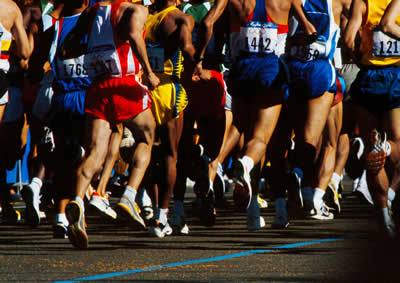By Danny Dreyer
ChiRunning
In ChiRunning, we utilize the principle of non-identification to help you in achieving your running goals, whether you are trying to start on a running program, improve your technique, or PR your 10K. Bottom line, non-identification requires that you get a grip on your ego. Ego is such a loaded word. Really, it's not a bad thing. It's a good healthy part of your psyche. However, when the ego runs the show, things can go out of whack. Non-identification doesn't ask you to drop your ego. It just asks you to keep it in balance with other aspects of your self, and especially with what your body has to say.
When the ego makes the choices without being balanced with the input of your body and being, your workouts and goals are probably out of balance as well. The ego is a two-sided coin. It can either inflate or deflate your sense of self. When inflated, it may demand that you run a 10K in 50 minutes when your body is really ready for a 56-minute run. This is a recipe for injury.
When deflated, your ego might give in to the nagging ache in your knee rather than trying just a little bit more to learn to lean and therefore not strike with your heels. When your ego is deflated, you give up too easily.
Non-identification is the art of making healthy decisions and of seeing yourself from a balanced place without judging yourself. If you are defining your self-worth by how well a run goes--either negatively or with an inflated sense of pride--then you are identifying with how you run. When you are non-identified, you evaluate your run, but not your self worth. You notice what you did well, what you need to improve upon and enjoy the process of learning and improving your running technique.
It doesn't mean you don't feel good about your accomplishments. As a matter of fact, when you are non-identified you may feel your accomplishments more deeply, more quietly and more profoundly. You may take more delight in the smaller things in your life. It also means that you don't judge yourself too harshly when things don't go the way you want. The voices of "I'm not good enough, fast enough or strong enough" will never help you accomplish anything.
Non-identification also means seeing the big picture of yourself. You are aware of your strengths, your challenges and your long-term goals. This knowledge helps keep you on track and keeps you from getting sidelined by the many lures of the ego.
To get to a place of non-identification, practice the Five Mindful Steps (from ChiWalking). First, think of the issue about which you need to make a choice, then:
1. Get Aligned -- Stand up straight. Feel your spine. Feel your posture straight from your head to your feet (or tailbone if you are sitting). This will give you some stability and a stronger sense of self and focus. Get aligned with your big picture goal. Does this choice fit in with that goal? Get aligned with supporting your goal in the best way possible.
2. Engage Your Core -- You want to listen to "the mind" of your body. To do so, focus your mind on your gut. Literally feel the area just below your navel and in toward your spine. Then, engage that part of your body on a physical level for at least 20 seconds or more. Now, ask the question regarding the choice you have to make. Can you notice how the answer has a different feeling than when you just engage your mind?
3. Create Balance -- Find the balance in your body physically by moving from foot to foot until you are balanced on both feet. Then move your torso until you find balance in your body. Now, allow your mind to explore your various choices. Try them on and look at them from various perspectives. Feel what each choice feels like.
4. Make a Choice -- From this place of alignment, core engagement and deep balance, you will be able to see yourself and make a choice from a non-identified, but healthy perspective. Your mind and ego will have had their input, but your body will have been included in the process.
5. Move forward -- Once you have made a choice. It is always good to take steps to move in your chosen direction. It will help instate the choice into your mind and body.
A few other ways to practice non-identification:
* Lighten up. Learn to laugh at yourself. If you can laugh at your mistakes, you are most likely in a non-identified place where you are not truly judging yourself, and you're not taking yourself too seriously. Life is short. Lighten up and learn to enjoy "what is" to stay healthy.
* Ask others. Get other people's opinions of what you should do and just listen to their ideas. You don't have to follow their advice, but be open to other perspectives.
* Run for fun. If you're too serious about your running, event, or goals you will have a tendency to get over identified. Make sure you really do run at least one fun run a week and keep it that way--just for pure enjoyment.
* Keep a log. Writing down the results of our workouts and runs can help you get perspective and solve any challenges you are facing.
Great running form doesn't just come from good technique (although it's a great place to start). It comes from having a healthy mental attitude. When you practice non-identification you might not just become a better runner, you might become a better person as well.
For beginners and competitors, practiced by thousands of runners, ChiRunning combines modern physics with the ancient wisdom of T'ai Chi to create a running form that is easily learned and makes running more effortless and enjoyable. To learn more, visit
www.chirunning.com




 When you send in your race results, please include the following: Name of race, date of race, your age, time, any age group award. Thanks
When you send in your race results, please include the following: Name of race, date of race, your age, time, any age group award. Thanks Upcoming Delco RRC birthdays this week: Gary Klein (Fri 8/27), Mary Ann McMenamin (Sun 8/29), Theresa White (Tue 8/31), Jean Massena (Wed 9/1). Stay young by joining us on one of our many Fun Runs and make new friends.
Upcoming Delco RRC birthdays this week: Gary Klein (Fri 8/27), Mary Ann McMenamin (Sun 8/29), Theresa White (Tue 8/31), Jean Massena (Wed 9/1). Stay young by joining us on one of our many Fun Runs and make new friends.
 If you take pictures at club events or already have pictures of recent club events/races, we have set up a Picasa web account for club members to use. This will enable the Club to keep an archive of pictures in one location which will be viewable by everyone. If you are interested in uploading pictures to our site, contact me and I will give you the login information. Click
If you take pictures at club events or already have pictures of recent club events/races, we have set up a Picasa web account for club members to use. This will enable the Club to keep an archive of pictures in one location which will be viewable by everyone. If you are interested in uploading pictures to our site, contact me and I will give you the login information. Click 